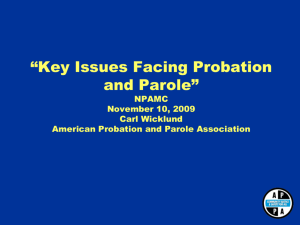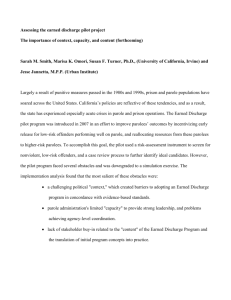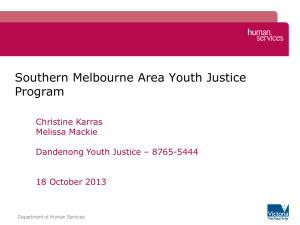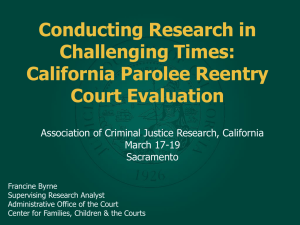Statement by Jesse Jannetta Research Associate, The Urban Institute
advertisement
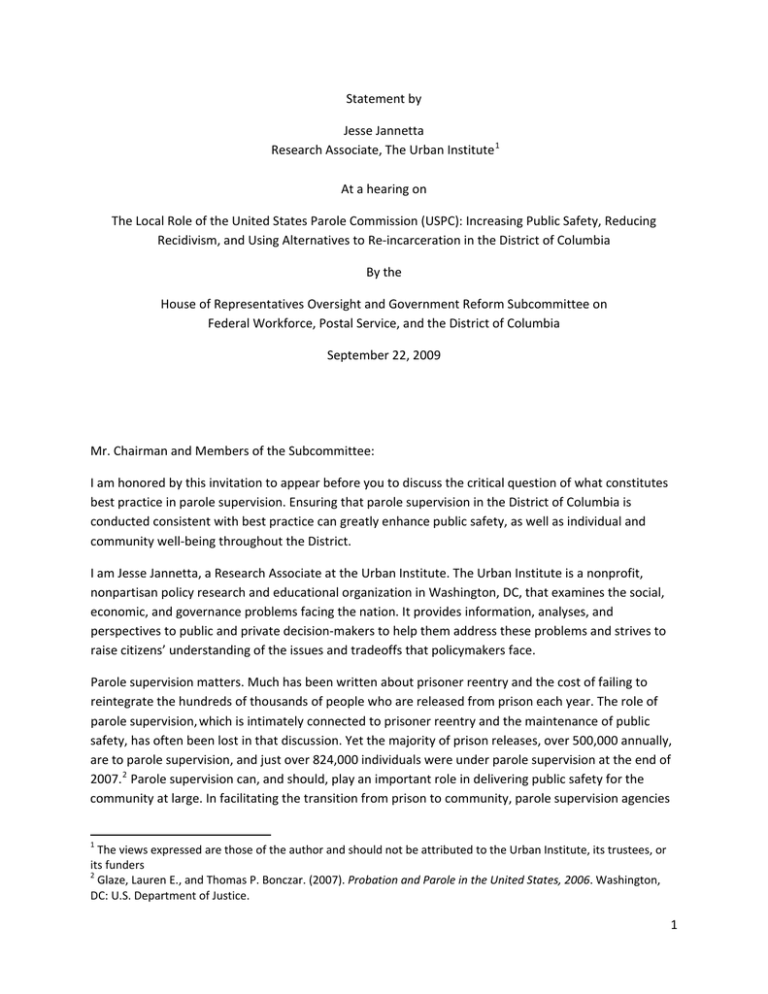
Statement by Jesse Jannetta Research Associate, The Urban Institute 1 At a hearing on The Local Role of the United States Parole Commission (USPC): Increasing Public Safety, Reducing Recidivism, and Using Alternatives to Re‐incarceration in the District of Columbia By the House of Representatives Oversight and Government Reform Subcommittee on Federal Workforce, Postal Service, and the District of Columbia September 22, 2009 Mr. Chairman and Members of the Subcommittee: I am honored by this invitation to appear before you to discuss the critical question of what constitutes best practice in parole supervision. Ensuring that parole supervision in the District of Columbia is conducted consistent with best practice can greatly enhance public safety, as well as individual and community well‐being throughout the District. I am Jesse Jannetta, a Research Associate at the Urban Institute. The Urban Institute is a nonprofit, nonpartisan policy research and educational organization in Washington, DC, that examines the social, economic, and governance problems facing the nation. It provides information, analyses, and perspectives to public and private decision‐makers to help them address these problems and strives to raise citizens’ understanding of the issues and tradeoffs that policymakers face. Parole supervision matters. Much has been written about prisoner reentry and the cost of failing to reintegrate the hundreds of thousands of people who are released from prison each year. The role of parole supervision, which is intimately connected to prisoner reentry and the maintenance of public safety, has often been lost in that discussion. Yet the majority of prison releases, over 500,000 annually, are to parole supervision, and just over 824,000 individuals were under parole supervision at the end of 2007. 2 Parole supervision can, and should, play an important role in delivering public safety for the community at large. In facilitating the transition from prison to community, parole supervision agencies 1 The views expressed are those of the author and should not be attributed to the Urban Institute, its trustees, or its funders 2 Glaze, Lauren E., and Thomas P. Bonczar. (2007). Probation and Parole in the United States, 2006. Washington, DC: U.S. Department of Justice. 1 can help parolees become productive citizens and reduce the harm they might cause by returning to crime, substance abuse, and other problematic behaviors. And parolees are returning to those behaviors. More than two‐thirds of those released from prison will be arrested and more than half will be reincarcerated within three years. 3 This pattern holds for those released to supervision as well as those released without it. 4 My testimony this morning will draw from work done by The Urban Institute and its project partners synthesizing the substantial body of research and expert knowledge regarding what constitutes effective parole supervision. That synthesis is reflected in the 13 parole supervision strategies contained in our report Putting Public Safety First. 5 Throughout this testimony I will draw heavily from that report, and anyone interested in a fuller treatment of the basis in research, theory, and practice of the strategies should refer to it. The 13 strategies are: 1. 2. 3. 4. 5. 6. 7. 8. 9. 10. Define success as recidivism reduction and measure performance; Tailor conditions of supervision; Focus resources on moderate‐ and high‐risk parolees; Front‐load supervision resources; Implement earned discharge; Implement place‐based supervision; Engage partners to expand intervention capacities; Assess criminogenic risk and need factors; Develop and implement supervision case plans that balance surveillance and treatment; Involve parolees to enhance their engagement in assessment, case planning, and supervision; 11. Engage informal social controls to facilitate community reintegration; 12. Incorporate incentives and rewards into the supervision process; and 13. Employ graduated, problem‐solving responses to violations of parole conditions in a swift and certain manner. My testimony is divided into four parts. First, I will discuss the recent change in orientation of parole supervision work and the promise it holds for reducing recidivism and enhancing public safety. Second, I will discuss the organizational‐level strategies necessary to realize that promise. Third, I will summarize case management–level strategies to do the same. Fourth, I will highlight factors important to consider in effectively implementing these strategies. Throughout my testimony, I will reference the relevant research findings and examples of practice in the parole field upon which the 13 strategies are based. I. The Changing Orientation of Parole 3 Langan, Patrick, and David Levin. (2002). Recidivism of Prisoners Released in 1994. Washington, DC: Bureau of Justice Statistics. 4 Solomon, Amy, Vera Kachnowski, and Avinash Bhati. (2005). Does Parole Work? Analyzing the Impact of Post‐ Release Supervision on Rearrest Outcomes. Washington, DC: The Urban Institute. 5 Available at http://www.urban.org/url.cfm?ID=411791. 2 The parole supervision field is in a period of ferment. Until recently, standard parole supervision relied heavily on surveillance, which has repeatedly been shown to have little impact on recidivism on its own. While surveillance and monitoring will always be important tools for supervision officers, supervision programs without a focus on treatment do not, on average, produce any reduction in recidivism rates. 6 However, since the late 1970s, a concentration on surveillance and enforcement is precisely the strategy that parole has been asked to implement. Contact standards became a key benchmark in assessing agency performance, and quick returns of violators a measure of vigilance. The national dialogue on prisoner reentry has created a unique opportunity for parole. In addition to their role in identifying and responding to parolee failures, parole supervision agencies can incorporate proactive strategies to change parolee behavior and prevent recidivism. Armed with a growing body of evidence regarding what works in correctional programming, 7 parole is ready to play a vital role on the reentry continuum, positioned perfectly to address the challenges of transition and reentry into the community. Around the country, a number of parole supervision agencies have begun to reshape, reform, and even transform their organizations along these lines. In Maryland, Kansas, Oregon, Michigan, Ohio, Georgia, and elsewhere, effective leaders have successfully implemented departures from parole business‐as‐usual in the direction of changing parolee behavior. This change in the parole supervision field is strongly evident in the results of the 2008 Parole Practice Survey conducted by The Urban Institute. We found that emphasis on evidence‐based practices to reduce recidivism is now widespread in parole in states across the country. 8 The use of tools underlying a behavior change approach to parole supervision such as risk/needs assessments and violations‐ sanctioning matrices and grids is now widespread. While much work remains to be done in the implementation of other key behavior change approaches (such as involving parolees in case planning to enhance their motivation and providing incentives for compliance), the clear trend in the parole supervision field is toward the direction of the 13 strategies. While the 13 strategies focus on what parole supervision agencies can implement on their own, it is important to recognize that parole supervision agencies cannot fully succeed in changing parolee behavior and delivering reentry success by themselves. Reentry success requires a commitment from a consortium of stakeholders: corrections; parole agencies; law enforcement; and other nontraditional partners, such as health and human service providers, housing authorities, workforce development boards, faith‐based organizations, and formerly incarcerated people. In particular, parole supervision agencies, institutional corrections, and releasing authorities must collaborate and align their practices toward common recidivism‐reduction goals in order to maximize the chances of delivering enhanced public safety. 6 Aos, Steve, Marna Miller, and Elizabeth Drake. (2006). Evidence‐Based Adult Corrections Programs: What Works and What Does Not. Olympia: Washington State Institute for Public Policy. http://www.wsipp.wa.gov/rptfiles/06‐ 01‐1201.pdf. 7 Ibid. 8 Results from the 2008 Parole Practice Survey reported in this testimony are from Jannetta, Jesse, Brian Elderbroom, Amy Solomon, Meagan Cahill, Barbara Parthasarathy, and William D. Burrell. (forthcoming). An Evolving Field: Findings from the 2008 Parole Practices Survey. Washington, DC: The Urban Institute. 3 This change in parole is being bolstered by signs of success from leading states. Parolees supervised under Maryland’s Proactive Community Services (PCS) model have arrest rates 31 percent lower than parolees under traditional parole supervision as well as a 9 percentage‐point difference in warrants for violation of parole. 9 Early returns from Transition from Prison to Community states Missouri, Michigan, and Georgia show decreases in recidivism, increases in successful completions of parole, and reductions in returns to prison. II. Organizational‐Level Parole Best Practices The first seven of the 13 strategies are best practices that must be implemented at the agency level. The first two (defining success as recidivism reduction and tailoring conditions of supervision) set appropriate accountability for both the parole supervision agency and the parolees. The other organizational‐level strategies involve the strategic allocation of resources, in terms of people (focus on higher‐risk parolees), time (focus on the period immediately after release from prison, discharge those who have successfully negotiated a set period), place (build neighborhood‐based parole caseloads), and partnerships (engage partners to expand intervention capacity). 1. Define Success as Recidivism Reduction and Measure Performance The 2008 Parole Practice Survey results make it clear that parole agencies overwhelmingly have the goal of reducing parolee recidivism. This is important, but it may be fall short of having clear targets for recidivism reduction and holding parole supervision agencies accountable for them, a model that has been very powerful in pushing performance in police departments. In the probation context, leaders have argued that setting such goals is a bold but necessary step to bring integrity to the field. 10 Comprehensive results‐tracking systems such as those used in Georgia, Indiana, and Oregon make it possible for the state to track parole supervision performance in recidivism and other outcomes of interest, such as parolee employment. The Kansas state legislature created the Kansas Sentencing Commission and charged it with measuring the state’s success at meeting the Kansas Department of Corrections goal of reducing parole and probation revocations by 50 percent. 2. Tailor Conditions of Supervision In many states, current practice relies heavily on subjecting parolees to standard conditions (such as abstaining from alcohol and drugs, maintaining employment and stable residence, and obeying all laws), augmented by special conditions to correspond with the characteristics of the parolee and the case. The result is often a long list of rules that do not differentiate the importance of various conditions over 9 Taxman, Faye S., Christina Yancey, and Jeanne E. Bilanin. (2006). Proactive Community Supervision in Maryland: Changing Offender Outcomes. Baltimore: Maryland Division of Parole and Probation. 10 Reinventing Probation Council. (2000). Transforming Probation through Leadership: The “Broken Windows” Model. New York: Manhattan Institute. 4 others. Surveillance‐oriented supervision based on a long and generic list of conditions without proper attention to the parolee’s criminogenic needs will not reduce recidivism. 11 Carl Wicklund, executive director of the American Probation and Parole Association, identifies “three R’s” of supervision conditions: They should be Realistic—few in number and attainable; Relevant— tailored to individual risks and needs; and Research‐based—supported by evidence that they will change behavior and result in improved public safety and reintegration outcomes. An example of such an approach is the Pennsylvania Board of Probation and Parole’s use of assessment information to tie conditions of parole to criminogenic risk factors. The result of setting conditions consistent with the three R’s is meaningful accountability. The parolee can meet all the conditions required, and all the conditions the parolee is required to meet have a meaningful relationship to reducing the likelihood of criminal behavior. Tailoring conditions in this way generally requires cooperation between the paroling authority and the parole supervision agency. 3. Focus Resources on Moderate‐ and High‐Risk Parolees From a strategic perspective, parole supervision resources should be focused on parolees at a moderate to high risk of reoffending because this population is more likely to benefit from treatment and supervision. 12 As higher‐risk offenders are by definition those having the greatest negative impact on public safety, directing resources at them will produce the greatest public safety benefit. Conversely, research has shown that treatment resources focused on low‐risk parolees tend to produce little, if any, positive effect. 13 It may even make their outcomes worse. 14 Resources are not only more supervision by itself, but supervision paired with treatment or other change interventions. Oregon and Washington State both use validated assessment instruments to determine which offenders will receive rehabilitative resources during their periods of supervision. Supervision alone does not ensure more successful outcomes because it does not address criminogenic factors or barriers to successful reentry, nor does it meaningfully address the motivation of the parolee. Focusing resources on higher‐risk parolees is another area in which collaboration is key, because the paroling authority often determines which individuals will be placed in high‐end, resource‐intensive supervision programs and who will participate in high‐end treatment programming. 4. Front‐Load Supervision Resources 11 See Cullen, Francis T., and Paul Gendreau. (2000). “Assessing Correctional Rehabilitation: Policy, Practice, and Prospects.” Criminal Justice 2000. Vol. 3: Policies, Processes, and Decisions of the Criminal Justice System. Washington, DC: National Institute of Justice, U.S. Department of Justice; and Petersilia, Joan. (2003). When Prisoners Come Home: Parole and Prisoner Reentry. New York: Oxford University Press. 12 See Andrews (2006); Aos, Miller, and Drake (2006); Austin (2006); Burke (2004); Burke and Tonry (2006); Cullen and Gendreau (2000); Jacobson (2005); MacKenzie (2006); National Research Council (2007); and Taxman (2002, 2006, 2007). Full citations available in Putting Public Safety First. 13 Lowenkamp, Christopher T., and Edward J. Latessa. (2004). “Understanding the Risk Principle: How and Why Correctional Interventions Can Harm Low‐Risk Offenders.” Topics in Community Corrections. Washington, DC: National Institute of Corrections; Petersilia, Joan, and Susan Turner. (1993). “Intensive Probation and Parole.” In Crime and Justice: A Review of Research, vol. 17, edited by M. Tonry. Chicago, IL: University of Chicago Press. 14 Lowenkamp and Latessa (2004). 5 The first days, weeks, and months after release from prison are a particularly high‐risk period for parolees, with arrests and parole violations twice as likely in the first month of parole as in the 15th month. 15 Parolees’ substance abuse, mental health, employment, housing, and other service needs are especially high during this period. 16 In response to this reality, supervision resources and strategies should focus on the period immediately after release. In fact, the beginning of supervision is so critical to individual success that parole agencies should not wait for the individual to be released to develop and implement a supervision plan. Early involvement in release planning by parole staff can contribute to success by helping the parolee understand the conditions of release and the expectations of the parole agency once release occurs. Jurisdictions can facilitate this process by transferring inmates to a facility closest to the city or town where they will return, as is done in Maryland. Front‐loading resources also helps identify which cases warrant enhanced supervision over a longer term and which do not. Parolees who do well and achieve their supervision goals require less supervision and perhaps even a shorter period of supervision. Focusing on those parolees who are most likely to commit new crimes allows parole supervision agencies to use their resources effectively and efficiently. Front‐loading supervision will not have the desired impact if it consists of increasing contacts without increasing supports. Simply watching parolees more closely in the first month may uncover more violations, but it will not in itself improve behavior or prevent crime. Several states, such as Michigan, Georgia, and Ohio, are beginning to align their supervision resources to support the individual just after release. These states begin “in‐reach” activities as individuals near the end of their incarceration so they can build relationships with parole officers and connect with employment resources, community services, and treatment providers before they are released. 5. Implement Earned Discharge Incentives for meeting case‐specific goals of supervision are a powerful tool to enhance individual motivation and promote positive behavior change. 17 A system of earned discharge whereby certain lower‐risk parolees can earn their way off supervision by adhering to specific goals and strict guidelines can serve as the ultimate incentive. A system of earned discharge contrasts to common parole practice in which parolees “successfully” complete their parole term based on the amount of time spent under parole supervision, not on how well they have done since leaving prison. The Parole Practices survey found that the ability to earn discharge from parole supervision is widespread in the United States. 15 Rosenfeld, Richard, Joel Wallman, and Robert Fornango. (2005). “The Contribution of Ex‐Prisoners to Crime Rates.” In Prisoner Reentry and Crime in America, edited by Jeremy Travis and Christy Visher (80–104). New York: Cambridge University Press. 16 Binswanger, I. A., M. F. Stern, R. A. Deyo, P. J. Heagerty, A. Cheadle, J. G. Elmore, and T. D. Koepsell. (2007). “Release from Prison—A High Risk of Death for Former Inmates.” New England Journal of Medicine 356(2): 157– 65. 17 Andrews, Don. (2006). “Enhancing Adherence to Risk‐Need‐Responsivity: Making Quality a Matter of Policy.” Criminology and Public Policy 5(3): 595–602; Burke, Peggy. (2004). Parole Violations Revisited: A Handbook on Strengthening Parole Practices for Public Safety and Successful Offender Transition. Washington, DC: National Institute of Corrections. 6 Earned discharge is of a piece with the front‐loading of resources to the period around release, in that it frees up resources that might otherwise go to the supervision of parolees who had demonstrated behavior change and were no longer in a high‐risk period of their supervision. 6. Implement Place‐Based Supervision Parolees are concentrated in a relatively small number of often‐disadvantaged neighborhoods in each state and jurisdiction. 18 Modeled on community policing strategies that have transformed the operations of many police departments, place‐based parole (also known as community‐based or neighborhood‐based parole) takes officers out of their offices and the confinement of 9‐to‐5 weekday work hours and into the neighborhoods where their parolees live and work. In a system of place‐based supervision, parole caseloads are geographically based, and parole officers may have satellite offices in the communities where high concentrations of parolees reside—places where risks are presumably higher. In urban settings, organizing caseloads by neighborhood efficiently allocates scarce resources and reduces costly and time‐consuming travel, for both supervising officers and parolees. It also facilitates parole officers finding opportunities for collaboration, opening lines of communication, and gaining greater trust from the parolee, their families, and other important stakeholders. While far from the norm, a few supervision agencies use place‐based supervision. Arizona’s pilot Legacy Project, for example, concentrates parole efforts in a particularly high‐impact zip code in Phoenix where officers work to address underlying problems associated with criminal behavior. Parole officers work in the neighborhoods where parolees live, engaging family and community support systems and partnering with social workers and service providers to find solutions to the challenges parolees face in the community. Maryland’s proactive community supervision (PCS) model includes place‐based supervision in four areas of the state. Parole agents are assigned geographically based caseloads; placed in the neighborhoods where parolees live and work; and given the resources they need, such as laptops, to effectively work in the community and away from their desks.19 7. Engage Partners to Expand Intervention Capacities Given the severe issues that many parolees need to address in order to change their behavior and remain crime free, including addiction, mental health, housing, education, and employment, it is essential for parole supervision agencies to partner with other government and private agencies, including community health care providers, housing authorities, substance‐abuse counselors, mental health service providers, workforce development boards, faith‐based organizations, and other relevant groups. Partnerships with these agencies can act as “force multipliers” to extend of parole supervision’s 18 La Vigne, Nancy G., Jake Cowan, and Diana Brazell. (2006). Mapping Prisoner Reentry: An Action Research Guidebook, 2nd ed. Washington, DC: The Urban Institute; Watson, Jamie, Amy L. Solomon, Nancy G. La Vigne, Jeremy Travis, Meagan Funches, and Barbara Parthasarathy. (2004). A Portrait of Prisoner Reentry in Texas. Washington, DC: The Urban Institute. 19 For more information, see http://www.dpscs.state.md.us/rehabservs/dpp/pcs.shtml or Taxman (2007) at http://www.dpscs.state.md.us/publicinfo/publications/pdfs/dpp_corrections_today.pdf. 7 ability to produce, support, and maintain positive change in individual parolees. Such collaborations are natural, as there is considerable overlap between parolees and the population receiving health and other human services. 20 The National Institute of Corrections’ Transition from Prison to the Community (TPC) initiative rests, in large part, upon the principle that transition and reentry are issues that belong not just to parole, corrections, or criminal justice agencies, but to a wide range of stakeholders. 21 TPC began its work in an initial group of eight participating states (Georgia, Indiana, Michigan, Missouri, New York, North Dakota, Oregon, and Rhode Island) with state‐level policy teams that involve the parole supervision agency and a wide range of public and private stakeholders whose work affects the practice of parole supervision. TPC has contributed to a growing realization that parole supervision agencies must collaborate with other stakeholders at the policy and case management levels to redesign and implement effective approaches to supervision that will enhance successful completion of parole supervision and improve reentry outcomes. 22 III. Case Management–Level Parole Best Practices I now turn to the final six of the 13 strategies, which focus on case management supervision strategies, involving the interactions between the parole officer and the parolee. They require a commitment to fostering a strong interpersonal relationship, one that is central to positive behavior change and parolee accountability. This relationship is the basis for the work of assessing risk and need factors, creating a supervision plan that addresses them, engaging parolees and their informal social networks in the work of community reintegration, and putting in place an incentive and sanction structure that promotes positive behavior change and intervenes as necessary to protect public safety. I will address each strategy in turn. 8. Assess Criminogenic Risk and Need Factors Parolees should be assessed to determine criminogenic risk and need factors and determine supervision levels so appropriate interventions can be delivered. Reliable, validated and normed assessment instruments are a better predictor of an offender’s risk and criminogenic need factors 23 than individual professional judgment. Such instruments can and should be used by parole officers to identify necessary interventions such as substance abuse treatment, and serve as a basis for supervision plans. It is crucial for parole supervision agencies to ensure that not only are such assessments conducted, but that the information is used by supervising officers in a meaningful way. 20 Fisher, C., M. White, and N. Jacobs. (2007). “FUSE Outputs and Outcomes.” Presentation to City of New York Department of Correction, New York (Criminal Justice Research and Evaluation Center, John Jay College of Criminal Justice), July 3; Cadora, Eric. (2002). “Criminal Justice Health and Human Services: An Exploration of Overlapping Needs, Resources, and Interests in Brooklyn Neighborhoods.” Paper presented at the U.S. Department of Health and Human Services From Prisons to Home conference, Washington, D.C., January 30–31, 2002. 21 Carter, Madeline M., Susan Gibel, Rachelle Giguere, and Richard Stroker, eds. (2007). Increasing Public Safety through Successful Offender Reentry: Evidence‐Based and Emerging Practices in Corrections. Silver Spring, MD: Center for Effective Public Policy. http://www.ojp.usdoj.gov/BJA/pdf/SVORI_CEPP.pdf. 22 For more information about TPC, see http://nicic.gov/TPCModel. 23 Criminogenic need factors are areas that research has shown are related to recidivism and that can be changed. 8 Many parolees will have been assessed while they were incarcerated, and the sharing of this information with parole can aid them in developing appropriate supervision plans. In current practice, however, information is often not shared across agencies or divisions. Departments of correction and parole agencies may use different tools to measure the same areas, resulting in confusing or inconsistent information. This is yet‐another area in which collaboration between institutions and community supervision would add great value in terms of effective community reintegration. 9. Develop and Implement Supervision Case Plans That Balance Surveillance and Treatment Each parolee should have a supervision case plan, informed by assessment, that lays out individual goals, conditions, and activities while under supervision. These plans should reflect treatment priorities as well as surveillance and enforcement, because research clearly shows that a combination of surveillance and treatment is more effective at reducing recidivism than surveillance alone. 24 Such plans will be maximally effective if they draw upon the principles laid out in the 13 strategies, such as focusing on the critical period immediately after release, using risk/needs assessment, involving the parolee in planning and goal‐setting, and incorporating incentives. The Center for Effective Public Policy created an integrated case management and supervision (ICMS) model 25 as part of their work on the TPC initiative that describes a collaborative effort to build a case management process that includes a transition accountability plan and involves shared responsibility between institutional corrections and parole. This approach aims to create a seamless process that makes it clear what individuals need to accomplish both before and after release and provides a structure for implementing many parole best practices around a single plan. 10. Involve Parolees to Enhance Their Engagement in Assessment, Case Planning, and Supervision Evidence‐based practices suggest that supervision should evolve from a contact‐driven system to a behavioral management model where the parolee actively participates in developing the supervision and treatment plan. 26 In a behavioral management approach, the routine interaction between parole officers and parolees is reframed as an intervention in itself, one in which effective communication is central. 27 Parole officers can use techniques like motivational interviewing and positive reinforcement to enhance parolee engagement and clearly communicate conditions of supervision, review assessment information, and develop case plans with parolees. They can also work with parolees to update and modify goals and supervision case plans as appropriate, increasingly the likelihood that parolees will “own” the plans for which they will be held accountable. This broader behavioral management approach 24 Aos, Miller, and Drake (2006); National Research Council Committee on Community Supervision and Desistance from Crime. (2007). Parole, Desistance from Crime, and Community Integration. Washington, DC: The National Academies Press. 25 Burke, Peggy. (2008). TPC Reentry Handbook. Washington, DC: National Institute of Corrections. 26 Burke (2004); Taxman, Faye S. (2006). “What Should We Expect from Parole (and Probation) under a Behavioral Management Approach?” Perspectives 30(2): 38–45. 27 Burrell, William. (2008). “Cognitive Behavioral Tactics: The Next Phase for Evidence‐Based Practices.” Community Corrections Report 7(1): 19–22. 9 has been implemented and evaluated in Maryland as part of the PCS program, with the positive results that I have already mentioned. 11. Engage Informal Social Controls to Facilitate Community Reintegration The vast majority of a parolee’s time is spent with family, friends, employers, and others, and interactions with their parole officer compose only a small fraction, even under more‐intensive supervision regimes. With proper support, even fragile informal networks can provide crucial resources, such as housing, crisis intervention, reinforcement for positive behavior, and a source of feedback for officers as parolees make decisions about supervision interventions. These informal relationships are typically more effective than formal controls in promoting positive change among individuals; 28 and, after formal supervision ends, it is these informal networks that must reinforce and support behavior change. Recently released prisoners overwhelmingly cite family ties as the most influential factor in staying out of prison. 29 Effectively engaging informal social controls will require many parole agencies to shift from a surveillance‐heavy mentality and contact‐driven approach. There are models they can look to regarding this transition, such as “citizen circles” in Ohio that encourage the involvement of parolee’s families, individual stakeholders, and various community members in the supervision of parolees. Composed of concerned citizens, citizen circles help parolees reconcile with their families, stay away from drugs and alcohol, develop personal decision‐making skills, find employment, and meet their treatment needs. 30 12. Incorporate Incentives and Rewards into the Supervision Process A great deal of attention is paid to sanctioning strategies for parolees, and much less to providing incentives and rewards for positive behavior. Yet incentives and rewards are powerful factors in motivating and reinforcing behavior change. Positive reinforcements should be used four times as often as negative sanctions to enhance individual motivation toward positive behavior change and reduced recidivism. 31 Examples of incentives and rewards include certificates of achievement; bus passes; food vouchers; reducing reporting requirements; allowing inmates to defer a monthly payment, appointment, or other requirement; eliminating conditions (such as home detention or program participation); or asking the parolee to be a mentor to other offenders. 28 National Research Council (2007). Visher, Christy, and Shannon M. E. Courtney. (2007). One Year Out: Experiences of Prisoners Returning to Cleveland. Washington, DC: The Urban Institute; La Vigne, Nancy G., Christy Visher, and Jennifer Castro. (2004). Chicago Prisoners’ Experiences Returning Home. Washington, DC: The Urban Institute. 30 For more information, see http://www.drc.state.oh.us/web/citizen/citizencircle.htm. 31 Bogue, Brad, Nancy Campbell, Mark Carey, Elyse Clawson, Dot Faust, Kate Florio, Lore Joplin, George Keiser, Billy Wasson, and William Woodward. (2004). Implementing Evidence‐Based Practice in Community Corrections: The Principles of Effective Intervention. Washington, DC: National Institute of Corrections. http://www.nicic.org/pubs/2004/019342.pdf. 29 10 As with responses to violations, to which I will turn next, responses to positive behavior should be swift and certain to have the greatest impact on behavior change. 32 This depends on the ability and willingness of parole officers to reward positive behavior as a risk‐reduction and behavior change strategy. Such an approach can be facilitated by incorporating positive reinforcement into guidelines for responding to both negative and positive parolee behavior, as Georgia has done in its Behavior Response and Adjustment Guide. 13. Employ Graduated Problem‐Solving Responses to Violations of Parole Conditions in a Swift and Certain Manner The purpose of responding to parole violations should be to confront behavior in a way that will change it without necessarily relying on a costly return to prison or jail that disrupts the reintegration process. High‐risk offenders who present a threat to the community should be returned to prison when they commit a serious violation or new crime. However, many parolees’ minor violations may be better met with swift and certain interventions that are both proportional to the severity of the violation and address the reasons that the violation occurred. 33 The availability of substance abuse and mental health services was associated with a reduced risk of technical violations and parole violations for low‐level criminal behavior in California, 34 which suggests that parole officers may be less likely to move to parole revocation if viable treatment alternatives are available in the community. In many parole agencies, a graduated, problem‐solving approach to parole violations could reduce the use of prison and jail beds for parole violators while also ensuring that all parole violations are addressed in some meaningful way. Research from multiple disciplines suggests that sanctions in response to negative behaviors (as with rewards in response to positive behaviors) should be swift, certain, and consistently applied to create and reinforce a deterrent effect. 35 Parole violations response guidelines or matrices are tools now in common use to ensure consistent approaches to parole violations. Some jurisdictions, such as Ohio, Pennsylvania, and South Carolina, encourage consistency in the disposition of violations with guidelines that help sort violations into categories, with various sanctions available at particular levels of authority. 36 NIC‐supported work in three states has shown that it is possible to reduce returns to prison without incurring additional criminal behavior among parolees. 37 32 Petersilia, Joan. (2007). “Employ Behavioral Contracting for ‘Earned Discharge’ Parole.” Criminology and Public Policy 6(4): 807–14; Taxman, Faye S., Eric S. Shepardson, and James M. Byrne. (2004). Tools of the Trade: A Guide to Incorporating Science into Practice. Washington, DC: National Institute of Corrections. http://www.nicic.org/Library/020095. 33 Burke (2004); Burke, Peggy B., Adam Gelb, and Jake Horowitz. (2007). When Offenders Break the Rules: Smart Responses to Parole and Probation Violations. Washington, DC: Pew Center on the States. 34 Grattet, Ryken, Joan Petersilia, and Jeffrey Lin. (2008). “Parole Violations and Revocations in California.” Washington, DC: National Institute of Justice, U.S. Department of Justice (Award #2005‐IJ‐CX‐0026). 35 See Burke et al. (2007). 36 For a discussion of the effect of such an instrument on outcomes, see Martin, Brian, and Steve Van Dine. (2008). “Examining the Impact of Ohio's Progressive Sanction Grid.” Washington, DC: National Institute of Justice, U.S. Department of Justice (Award #2005‐IJ‐CX‐0038). 37 Burke et al. (2007). 11 IV. Implementing Parole Best Practices Too often, best practices such as the 13 strategies are thrown at an organization with little or no attention to the intricacies of implementation. One area often neglected in planning change in practices is examination of the organizational infrastructure. The infrastructure of organizations evolves in response to the collective sense of what the purpose and priorities of that organization are, and no parole supervision agency will be able to broadly and lastingly implement behavior‐change approaches to parole supervision if that approach is not reflected in the organizational infrastructure. The elements of organizational infrastructure include the following: • • • • • • • • • • • Mission and goals Strategies and programs Performance measurement and management systems Information technology Recruitment and retention policies Job descriptions Training Performance appraisal and reward systems Supervisory roles and responsibilities Organizational culture Interagency collaboration These elements must be reviewed to determine if they align with parole supervision best practices such as the 13 strategies. Many parole officers already incorporate principles in accord with the 13 strategies into their supervision, not because experts told them to do so, but because their experience and understanding of the job have brought them to the same insights. We will know that parole supervision has changed to maximize public safety and benefit when the leadership, training, performance measurement, and promotion and reward structures within parole organizations recognize and reward that kind of supervision. Leadership is the single most important element in effecting that type of organizational change. It is essential that those in leadership positions first and foremost express a willingness to assume the daunting and often vexing challenges associated with retooling parole organizations. The adoption of parole supervision strategies consistent with the 13 strategies will require a substantial redirection in vision, mission, and focus for many agencies currently responsible for post‐prison supervision. V. Conclusion Over the past 30 years, numerous changes to sentencing laws have resulted in the imposition of lengthier sentences and have required offenders to serve longer periods of incarceration before being eligible for release. These shifts have produced a dramatic growth in prison populations and a historically unprecedented number of individuals returning home each year. These changes carry 12 enormous public safety implications for communities and neighborhoods when hundreds of thousands of prisoners released annually from prison are singularly ill‐equipped to succeed and poorly supported during and after their transition home. There is a growing desire and pressing public policy need to identify effective, evidence‐based models of parole supervision that promote public safety, emphasize offender accountability, and foster desistance from crime. In developing the 13 strategies, the Urban Institute and its partners sought to collect, analyze, and clearly present what constitutes such parole supervision. In surveying the parole field, it is clear that states all over the country are adopting practices consistent with the 13 strategies, and some are beginning to realize the benefits of doing so. Parole agencies face tremendous challenges in supervising the safe and successful reintegration of the huge number of individuals returning from prisons, but they also have a tremendous opportunity to contribute to safer and healthier communities. Jurisdictions across the country are working to seize that opportunity. We need to recognize, support, and learn from those who are doing so, and push those who are not to emulate them. Thank you for your time. I welcome any questions you may have. 13
